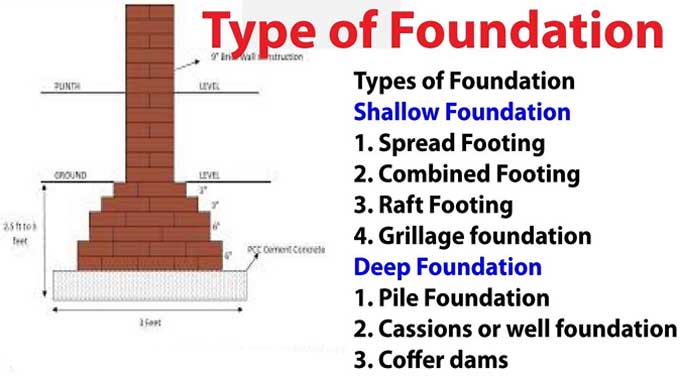The part of the structure that lies below the ground level and is responsible for transmitting lead to the ground is called a foundation.
Functions/Objectives of foundations
1. The load on the superstructure (above the ground) is distributed over a large area of soll.
2. The Intensity of the load (Pressure) should not be greater than the S.B.C. soil.
3. Lateral stability of structure against Horizontal forces (Wind, Earthquake).
4. Soil Reduse Soll erosion/removal dus to wind or rain
5. Provides a level surface for the superstructure to be raised on it.
6. Provide safety against undermining or scouring by water or burrowing animals.
Bearing Capacity of soil
The ability of the soil to support the load coming on it without any sort of failure is defined as the bearing capacity of the soil.
This property of the soll is defined with other names such as bearing power or bearing value of the soll.
Ultimate Bearing Capacity
it may be defined as the intensity of the loading (Maximum) at the base of the foundation, which will cause shear failure in the supporting soil. Also, another term is Safe Bearing Capacity which is known as Ultimate bearing capacity or Factor of Safety (FOS).
The factor of safety or Foß should be from 2 to 3 for the soll where the load is to be carried.

Loads on foundation
a) Dead load: This load Includes the self-weight of various structural components which are to be constructed over the load bearing area (considering future construction also).
b) Live Load: This load Includes super imposed /movable load applied on the floors. E.g. persons, materials, snow,
c) Wind Load: The Intensity of pressure due to the wind applicable over the area that come in direct contact with the wind.
Essential Requirements of a Good foundation
1. A good foundation should resist any future unexpected adverse effects on its performance
2. It should be safe and stable against any possible fallure.
3. No settlement or deflection to such extent that will Impair its usefulness.
Types Of Foundation | Used in Building Construction | Deep and Shallow Foundation
Types of foundations
The two different types of foundations are:
1. Shallow foundation
2. Deep foundations
Shallow foundations (sometimes called ‘spread footings’) Include pads (isolated footings”), strip footings and rafts whereas deep foundations include plles, pile walls, diaphragm walls and caissons.
Shallow foundations: These are further classified as
• Pad foundations
• Strip foundations
• Raft foundations
Shallow foundations are those founded near to the finished ground surface; generally where the founding depth (D) in less than the width of the footing and less than 3m.
Shallows foundations are used when surface solls are sufficiently strong and stiff to support the Imposed loads: they are generally unsultable in weak or highly compressible soils.
Pad foundations are used to support an individual point load such as that due to a structural column. They may be circular, square or rectangular.
They usually consist of a block or slab of uniform thickness, but they may be stepped or sloped if they are required to spread the load from a heavy column. Pad foundations are usually shallow.
Deep foundations
Deep foundations are those founding too deeply below the finished ground surface for their base bearing capacity to be affected by surface conditions, this is usually at depths >3 m below finished ground level.
They include piles, plers and caissons or compensated foundations using deep basements and also deep pad or strip foundations.
Deep foundations can be used to transfer the load to deeper and more competent strata at depth if unsuitable soils are present near the surface.
Piles are relatively long, slender members that transmit foundation loads through soil strata of low bearing capacity to to deeper soll or rock strata having a high bearing capacity.
They are used when for economic, constructional or soil condition considerations it is desirable to transmit loads to strata beyond the practical reach of shallow foundations.
Plers are foundations for carrying a heavy structural load which is constructed in a deep excavation.
Caissons are a form of deep foundation which are constructed above ground level, then sunk to the required level by excavating or dredging material from within the caisson.